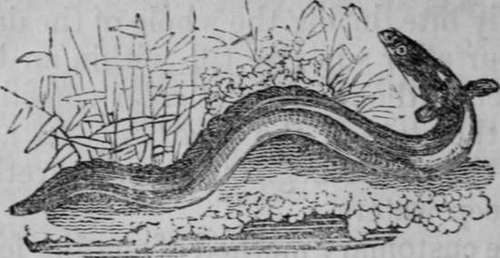A Description Of A Eel
Description
This section is from the book "The Art Of Angling Greatly Improved", by An Unknown Author. Also available from Amazon: The Art of Angling Greatly Improved.
A Description Of A Eel
It has been long a matter of dispute in what manner Eels are generated. Lacepede, the eminent French naturalist, decides, in the most unqualified terms, that they are vivipo-rous; whilst, on the other hand, Sir Humphrey Davy, in his Salmonia, considers them to be oviparous. Sir Everard Home regards them as hermaphrodites. Leaving this dispute, however, to be settled by naturalists, we have only to instruct the angler in what manner they are to be caught.

The favourite haunts of Eels are still waters amongst weeds, under the roots of trees and large stones, and in the clefts of the banks of rivers. The habits of the Eel are nocturnal, and the finest and largest are usually caught with night-lines. The best bait for angling is the lob-worm, the hook small, about No. 3 or 4, and it is proper to use a small plumb or pistol-bullet. They bite best in dark cloudy weather, after showers attended with thunder and lightning.
There are two ways of fishing for Eels, peculiar to that fish alone; the first is called sniggling, which is performed as follows : Take a short strong rod, and a line exceedingly strong with a small hook, which must he baited with a lob-worm well scoured; the end of the hook must be placed slightly in the cleft of a stick, in order that it may easily slip out. With the stick and the hook thus baited, search for holes under stones, timber, roots, or about flood-gates. If an Eel be there he will certainly bite; but let him tire himself by tugging, before any attempt be made to pull him out, or otherwise the line will be broken.
The second method is called bobbing, which is thus: Take the largest garden worms, scour them well, and with a needle run a very strong thread or silk through them from end to end, as many as will lightly wrap a dozen times round your hand; then tie them fast with the other two ends of the thread or silk, in order that they may hang in so many long hanks ; then fasten all to a strong cord, and about three inches above the worms fasten a piece of lead of about three quarters of a pound, making the cord fast to a long and strong pole. With the worms thus arranged, you will find the Eels trig strongly at them, and when it is supposed that they have swallowed the bait as far as they can, draw the worms and the Eels gently up, but when they are at the top of the water, then pull them up with all your strength suddenly, and land the fish as speedily as possible.
The following is the most approved method of fixing the night-lines for Eels. Having made a sufficient number of links of twelve hairs, double them, and tie a small strong hook to each link, having an equal number of strong whip-cord lines, about twelve or fifteen yards each, which have been used, and are soft, such as old trolling or Barbel lines ; fasten one end to a small stake of ash or hazel about a foot long and pointed at one end, making a noose at the other end of each line large enough to admit a Dace or a Gudgeon; fasten a bullet about a foot from the noose ; take the links and bait them with Gudgeons, Minnows, or lob-worms (the former are to be preferred) by making an incision with the point of the baiting-needle at the shoulder, running it under the skin, and out at the middle of the tail, drawing the link after it. The point of the hook should be upright towards the back, and it matters not how proud, as the Eel is a most voracious fish. Take the lines to the pond or river in the evening, and unwinding a line from the stake, peg it fast to the ground near the side. Take one of the links baited, put the noose of the link upon the line, and drop the bait through the noose upon the line. Throw the bait in a good way, but not to the extent of the line, as Eels will run a little before they gorge. A hundred of these lines may be laid in a short time.
Continue to:
